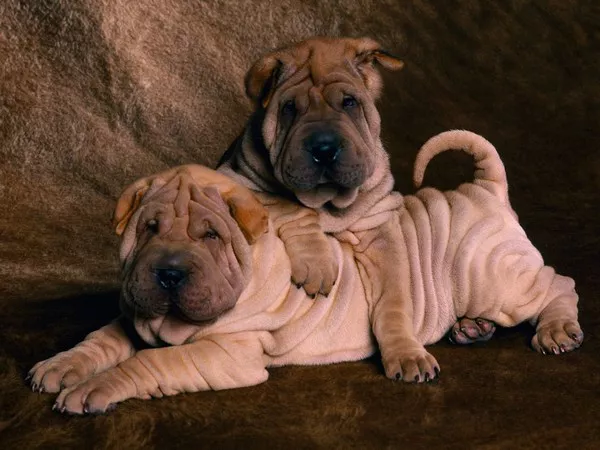The Shar Pei, known for its distinctive wrinkled skin and unique appearance, is a breed that has captured the hearts of dog enthusiasts worldwide. If you’re considering adding a Shar Pei to your family or simply curious about their growth and size, you’ve come to the right place. In this article, we’ll explore just how big a Shar Pei can get and what factors influence their size.
1. Average Size of an Adult Shar Pei
Adult Shar Peis are considered a medium-sized breed. On average, male Shar Peis typically stand between 18 to 20 inches (46 to 51 centimeters) at the shoulder, while females are slightly smaller, ranging from 17 to 19 inches (43 to 48 centimeters). This measurement is taken from the ground to the top of the shoulder, known as the withers.
2. Weight Range
In addition to height, weight is another important aspect of a Shar Pei’s size. Adult Shar Peis generally weigh between 45 to 60 pounds (20 to 27 kilograms). However, individual dogs may fall outside this range, with some Shar Peis being lighter or heavier depending on factors such as genetics, diet, and exercise.
3. Growth Stages
Understanding the growth stages of a Shar Pei is essential for pet owners and breed enthusiasts. Here’s a breakdown of their development:
Puppy Stage: Shar Pei puppies are born small and grow rapidly during their first few months. Proper nutrition and care during this stage are crucial for healthy growth.
Adolescence: As they enter adolescence, Shar Peis may experience growth spurts. This is a critical time for providing a balanced diet to support their development.
Adult Stage: By the age of 12 to 18 months, Shar Peis typically reach their full height and weight. Keep in mind that individual growth rates may vary.
4. Factors Influencing Size
Several factors can influence the size of a Shar Pei:
Genetics: The genetics of the parents play a significant role in determining a Shar Pei’s size. If both parents are within the breed’s standard size range, their offspring are more likely to fall within that range as well.
Nutrition: Providing a balanced diet during the puppy stage is crucial for healthy growth. Overfeeding or underfeeding can impact a Shar Pei’s size and overall health.
Exercise: Regular exercise helps maintain a Shar Pei’s muscle tone and weight. Adequate physical activity is essential for their overall well-being.
Health: Health issues or medical conditions can sometimes affect a dog’s growth. Regular vet check-ups are essential to monitor their health and address any concerns.
Conclusion
In conclusion, the size of a Shar Pei can vary slightly, with males typically being larger than females. Adult Shar Peis are considered medium-sized dogs, standing between 17 to 20 inches tall and weighing between 45 to 60 pounds. Proper nutrition, exercise, and genetics all play a role in determining their final size.
FAQs about Shar Pei dogs:
Q1: What is the origin of the Shar Pei breed?
A1: The Shar Pei breed originated in China and has a history dating back over 2,000 years. They were originally bred for various purposes, including hunting, guarding, and herding. Their distinctive wrinkled skin and unique appearance are some of their most recognizable features.
Q2: Why do Shar Peis have wrinkles?
A2: Shar Peis have wrinkles due to a genetic condition known as “dermatitis.” This condition causes extra loose skin to form, resulting in the characteristic wrinkles. While these wrinkles are most prominent in puppies, Shar Peis tend to grow into their skin as they mature.
Q3: Are Shar Peis good family pets?
A3: Yes, Shar Peis can make excellent family pets. They are loyal, protective, and bond closely with their families. However, they can be reserved or aloof with strangers, so early socialization is essential to ensure they are well-adjusted and friendly with new people.
Q4: Do Shar Peis get along with other pets, like cats and other dogs?
A4: Shar Peis can get along with other pets, but their temperament can vary. Early socialization is crucial to help them adapt to other animals in the household. Some Shar Peis may have a strong prey drive, so introductions should be supervised.
Q5: Are Shar Peis easy to train?
A5: Shar Peis are intelligent but can be independent and stubborn at times. They require consistent and patient training using positive reinforcement techniques. Early training and socialization are vital to ensure they grow into well-behaved companions.
Q6: Do Shar Peis shed a lot?
A6: Shar Peis have a short, bristly coat that is relatively low-shedding compared to some other breeds. However, they do undergo seasonal shedding, and regular brushing can help manage loose hair. Proper grooming is essential to maintain their coat and skin health.
Q7: What are some common health concerns in Shar Peis?
A7: Shar Peis are prone to certain health issues, including skin problems due to their wrinkles. They can also be susceptible to hip dysplasia, entropion (a condition where the eyelids roll inward), and respiratory issues due to their short muzzle. Responsible breeding and regular vet check-ups are essential to monitor and address these concerns.
Q8: How big do Shar Peis typically get?
A8: Shar Peis are a medium-sized breed. Adult males typically stand between 18 to 20 inches (46 to 51 centimeters) at the shoulder, and females are slightly smaller, ranging from 17 to 19 inches (43 to 48 centimeters). Their weight generally falls within the range of 45 to 60 pounds (20 to 27 kilograms).
Q9: What is the lifespan of a Shar Pei?
A9: The average lifespan of a Shar Pei is around 9 to 11 years. Providing them with a balanced diet, regular exercise, and proper veterinary care can contribute to a longer and healthier life.
Q10: Are Shar Peis suitable for apartment living?
A10: Shar Peis can adapt to apartment living, but they require daily exercise and mental stimulation. They should have access to a secure outdoor area for play and exercise. Adequate exercise and mental engagement are essential for their well-being.


